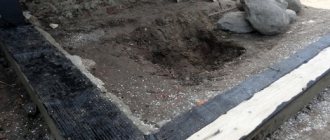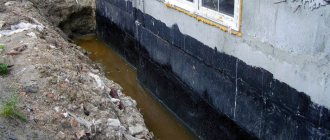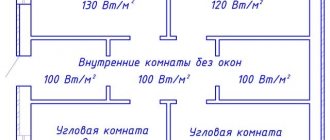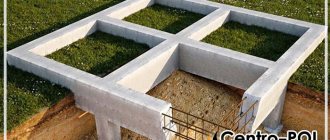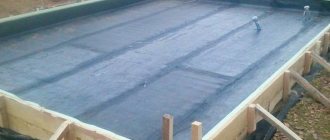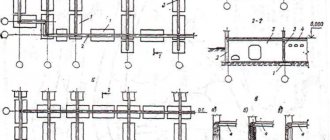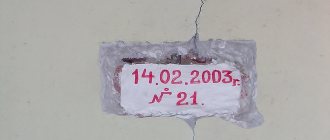To save the basement from moisture penetration, the foundation is waterproofed. To implement it, there are certain rules, violation of which will lead to irreparable consequences. Eliminating errors will require additional money, time and effort.
Why is waterproofing needed?
Work related to foundation waterproofing is considered an integral stage in the construction of low-rise private houses.
The need to use waterproofing materials is explained by the presence of moisture in the soil composition in most regions of the country. Water in a concrete structure is not too dangerous, but there are certain rules for protecting it:
- Concrete has the inherent property of capillary movement of moisture through small pores inside the structure. Thus, water flows from the outer surfaces of the structure to its inner layers, and is selected to the load-bearing walls bordering the foundation surface. Dampness and fungal mold appear, the cost of heating the premises increases, the interior decoration of the rooms becomes unusable;
- modern foundation structures that comply with SNiP consist of metal and concrete mortar. When steel reinforcing bars come into contact with water, they begin to corrode. In addition, the metal increases its volume three times, forming strong pressure on the foundation from the inside and creating destructive processes;
- In winter, frost sets in, turning moisture into ice. Being in the concrete layer, water destroys its structure.
There is another danger. Often, groundwater contains chemical components that have an aggressive effect on the concrete surface.
Waterproofing for the foundation prevents these negative processes.
Mineral and roll waterproofing
Plaster waterproofing is a fairly expensive method. At the same time, laying waterproofing on a monolithic foundation gives a more positive effect than plastering a prefabricated foundation. Mineral insulation, created from cement and polymers, creates a moisture-proof layer with elastic properties. Therefore, it is recommended for protecting monolithic foundations from the inside.
Pasted roll waterproofing is a special membrane that is applied to the surface using a burner. Innovative moisture protection of this type is produced using technology - protective profile. This technology speeds up installation work and increases the service life of the material. This type of insulation will be ineffective if the seams are poorly sealed and the seal is broken. However, if you carry out all the work following the instructions, you can avoid breaking the tightness of the waterproof layer.
Factors influencing the choice of methods and materials
Waterproofing under the foundation is possible in two ways:
- at the time of pouring, moisture-proof concrete is used, intended for the construction of bridge supports;
- the foundation is covered with one of the types of waterproofing materials.
What is the final choice of developers in arranging foundation waterproofing? In most cases, this is the second option. The reasons for this decision are:
- the increase in the cost of concrete mortar with an increase in the coefficient of moisture resistance is thirty percent or more;
- not every factory can order the production of such material;
- When delivering special moisture-resistant concrete, certain difficulties arise, and its laying is carried out according to a special technological map.
Using one of the types of coating for waterproofing and having certain skills in performing such work, everything can be done with your own hands.
Materials used to protect the foundation structures of buildings are divided into several groups:
- coating;
- sprayed;
- roll;
- penetrating;
- screen;
- plaster waterproofing.
What should the choice be?
If the foundation is slab and monolithic, then a combined option is suitable, including both horizontal and vertical protection. Bitumen roll or “rubber” are more preferable. Bitumen or plaster waterproofing is suitable for tape. Pile foundations will require additional anti-corrosion treatment.
How to properly waterproof a foundation? Don’t let savings beat you, choose the material carefully, consult with specialists. And remember that it is better to be on the safe side.
Types of waterproofing
In the construction industry, the following methods of waterproofing the foundation of a house are used.
Horizontal
Some people call this type cut-off foundation waterproofing. It is used to prevent the penetration of moisture from one level to another. Such waterproofing, installed between the foundation and the load-bearing wall, is used for any load-bearing structure - strip, monolithic, pile.
Vertical
This method of protection during the construction of a residential building is used for an existing foundation. Vertical protection is intended to treat the base of the building from the negative effects of surface moisture. It is used when arranging support structures of strip and column type.
Outdoor
Why do you need waterproofing on the outside if the house is already built?
The external method of protection preserves the foundation from the effects of precipitation and melted snow and implies the construction of a blind area.
For this purpose, concrete or asphalt concrete, paving slabs, clay, and special membrane materials are used. All work is carried out in accordance with the current GESN, ENIR and GOST standards, which determine the technologies for arranging the blind area and the materials recommended for this. External protection is widely used in the construction of multi-storey buildings.
Internal
Waterproofing of foundation walls can be done from the inside. It is necessary to select a suitable material and treat the basement walls and floor with it.
Materials used
So, waterproofing the foundation is its reliable protection from the negative effects of moisture, for which various moisture-resistant materials are used.
Rolled
With their help, high-quality protection of reinforced concrete surfaces, waterproofing of foundation expansion joints and areas between the foundation and masonry are performed.
Rolled materials can be fused or bonded. In the first case, the presence of an adhesive base that is subject to heating is implied; for the second type, bitumen mastics are used.
The group of these materials includes the following types:
- roofing felt, roofing felt, glassine. Outdated, but affordable materials, with the help of which reliable waterproofing of masonry from the foundation is arranged;
- polymer building materials, the fiberglass or polyester base of which is impregnated with bitumen. The main examples of such a group are Linocr, Gidroizol, Stekloizol, Bikrost, Technoelast, etc. The main distinguishing feature of such materials is the pimpled surface of the upper protective layer.
The second group of materials is considered more reliable, but, as determined by FER (Federal unit prices for construction work), the cost of their installation is quite high.
Liquid
In most cases, these are bitumen mastics, divided into one-component and two-component compositions. In addition, the building materials market offers polymer-based resins with the addition of bitumen or rubber.
What it is? These are liquid materials for waterproofing that do not crack under the influence of temperature changes. The main disadvantage is the high cost compared to simple bitumen-based mastic, which is recommended for treating underground parts of buildings if the groundwater level is deep enough.
Gel-like
The technology for insulating the foundation from the effects of water also involves the use of such modern materials as Penetron, Penecrit, Peneplag and Hydrohit.
In this way, the concrete surface is protected from moisture penetration into it. In addition, the strength of the base increases.
How to properly make a protective layer? The material is simply applied to the surface, penetrating the reinforced concrete structure to a depth of fifteen to twenty-five centimeters.
Only concrete bases are treated with such compounds; their use on brick or stone is prohibited.
Foundation waterproofing and its foundations
Any soil contains some amount of moisture. Groundwater has a negative impact on building structures, therefore, the foundation must be reliably protected. In construction, both standard waterproofing and combined with a drainage system that removes water are used.
In private construction, the anti-filter system is quite popular, which does not allow moisture to penetrate into the underground room. In industrial construction, an anti-corrosion water protection system is more often used. Recently, this system has begun to be used in the construction of cottages.
Waterproofing the foundation of a building is divided into several types:
- Based on agents that are introduced into concrete to give it elasticity and plasticity.
- By coating, for example, with polymer compounds.
- Plaster insulation.
- Pasting method, where bitumen is used as the material.
- Mechanically secured.
The choice of option depends on the type of construction and operating conditions of the building.
Waterproofing methods
Let's try to figure out what is the best way to waterproof the foundation, what material to choose for this in order to reliably protect the structure and not go beyond the limits of the structure. Taking into account existing innovations, it is easy to perform the appropriate calculations and determine the best option for the job.
So, the following methods are used to waterproof the foundation.
Coating
This method is also called painting. This group of materials includes liquid bitumen-based compositions that can remain on the concrete surface for no more than six years. After this period, cracks appear on the protective layer, and the foundation unit needs to restore the waterproofing.
This protection option is used to treat the surface from groundwater and melt water.
The thickness of the applied layer is one to three millimeters, the solution fills the pores, reliably sealing them from moisture. During work, it is recommended to take precautions to protect the skin and respiratory organs from solutions.
In addition to bitumen-based materials, liquid glass is used.
Coating compounds are considered affordable and can be easily applied to the side surface of the foundation with a spatula.
Unfortunately, checking the results of using such a waterproofing layer shows that it is not durable and requires additional protection from the formation of fungal mold.
Penetrating
The mixtures are comparable to coating materials, and let’s try to figure it out together which one is better.
Today they are considered a new product in this segment, their appearance resembling a conventional primer composition of a white or ceramic shade. The consistency consists of acrylic, polymers and small particles in the form of small vacuum capsules, which reduce the thermal transfer coefficient of the structure treated with this composition.
Elastic compounds are perfectly applied to a reinforced concrete surface, protecting it from the negative effects of water, mold and rust.
The main advantages of this method of protection are:
- efficiency. If you are in doubt about how many layers of waterproofing are needed for the foundation, perform one treatment, and this will be enough;
- light weight;
- quick drying, easy application, use on any surface, long service life, up to fifteen years.
Builders note the fragility of the material as a disadvantage. If the foundation cracks, the layer of penetrating material loses its protective qualities. Whether or not such insulation from moisture is necessary is up to you to decide.
Pasting
It is carried out with all types of rolled materials, differing in reasonable cost. With their help, reliable protection is created for both new and old foundations, but its service life leaves much to be desired. In this regard, many people wonder whether finishing the base with ordinary roofing material is necessary if its service life does not exceed three years.
True, material manufacturers today are releasing new products that are distinguished by an increased level of strength, the presence of polyester reinforcement and the content of other components that improve the protective properties of the covering layer.
True, there is one peculiarity - such materials are applied in two layers.
This group of building materials owes its name “pasting” to the presence of an adhesive base, which is used for gluing to a concrete wall.
However, such insulation must be applied carefully so as not to damage the material. Surfacing involves the use of a gas burner, which also creates certain difficulties associated with additional costs.
Membrane
For its manufacture, special PVC sheets are used, to which plasticizers are added. Due to such additives, the service life of the membrane material increases to fifty years.
The material is resistant to temperature changes and chemicals, does not stick together, does not stick to the concrete surface, and is elastic, which allows it to work at any time, whereas it is often necessary to withstand the process of shrinkage of the base so as not to damage the waterproofing material.
To the question of how many days after pouring the foundation can protection from moisture be installed, we will answer simply - immediately after it hardens.
There are several disadvantages - the work is performed using special equipment, and the cost of the material is quite high.
Mountable
This is not a very common option, because it is made with compacted clay. Such protection is arranged in this way:
- a bentonite mat is placed between geotextile material and cardboard, which then decomposes in the ground;
- the mat remains in its original state, forming a dense clay layer.
It should be noted that this type of waterproofing is almost never used for the basement surface, where there is contact with the air.
Injection
Another effective option with its own advantages. Such insulation has a long service life, reliably protects against water, does not change its qualities due to temperature, does not corrode, and helps conserve thermal energy.
The injection material is used in combination with liquid rubber or glass, it is characterized by elasticity, flexibility, manufacturability, environmental safety, and creates good adhesion.
It should be noted that such material is completely repairable; all damage from mechanical stress or high temperatures can be easily eliminated.
When can this composition be applied? As soon as the foundation base has hardened, it is allowed to carry out processing, during which the waterproofing composition is evenly distributed. If everything is done correctly, seam areas, small cracks and other defects will become invisible.
The disadvantage is a five-year service life, after which it is recommended to repeat the treatment.
Sprayable
This insulation is applied by spraying. All work is carried out easily; no preparatory measures should be carried out. The materials for spraying are simple cement compositions to which plasticizers with penetrating properties are added.
There is a drawback - the surface must be reinforced before applying the protective layer to ensure reliable adhesion. Unfortunately, it is not entirely convenient to install such waterproofing for a pile foundation.
Plastering
This type of insulation is classified as coating type and is performed using solutions based on asphalt, sand and cement with the addition of special components. In addition to ordinary concrete surfaces, the plastering method is used to protect foundations built from FBS blocks.
A few words should be said about waterproofing with polyurea. The name is unpleasant, but that's all. This name was given to a polymer substance based on polyester components, whose viscosity imparts plasticity to the coating.
